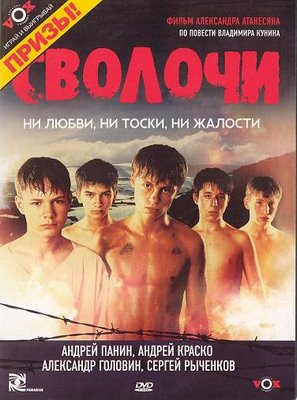
(2002, Russia, Stereoblood, Odinochestvo krovi)
A trippy Russian serial killer thriller...
I think that reading about the recent Russian slasher Dead Daughters lead me to this, with the promise of a Russian giallo, which isn't a bad way to approach it. But while the oblique camera angles, experimental camera moves and eclectic soundtrack all work in the film's favour, the techniques strangely aren't applied as energetically to the murder scenes, which horror fans would expect to be the 'set pieces' of the genre. I'd highly recommend this, not so much for the horror angle, but as a murder mystery presented as a subtly disorientating trip.
Maria is trying not to worry that her husband has been missing for three weeks. Added to this is an impending deadline at work that's hugely imporant for her company. Elsewhere in the city, a vicious killer is picking off isolated victims with a particularly nasty knife...

The story keeps us guessing which direction it's is going in, hinting at all sorts of possibilities. It's a nightmarish murder mystery, with a mood that's ideal for watching after midnight.
The expert camerawork repeatedly attempts to disorientate the viewer, mimicking Maria's loose grip on her situation. Like the style of Requiem for a Dream, there is an emphasis on insignificant sounds, the audio changing with each camera angle - a technique normally avoided to lessen the effect of the visual 'cut'. (Should sound be directional every time the editor moves the viewpoint? Discuss.) Some of the floating camerawork, not quite aimed at the action, pushed me slightly towards travel sickness at one point. In conclusion, the cumulative effect is gently trippy.
There's a theramin scene that hints at the eccentric ecesses of a Dario Argento murder, and there's also a visual nod to Psycho (well, it's playing on TV!). But I was more reminded of Brian De Palma's Dressed To Kill, probably for the lift scene. A homage to a Hitchcock homage, perhaps.
Thankfully, for a nightmare scenario of this nature, there's none of the increasingly dull 'is it a dream' moments. Instead Maria's disorientation is used to increase suspense, as most of her friends aren't taking her plight seriously, and that she might also be in danger because she's misreading the situation.

Ingeborga Dapkunaite as Maria is superb. She doesn't overplay her plight and totally held my attention and sympathy. The actress has already played many small roles in American and British films and TV (Hannibal Rising, Bodies, Shadow of the Vampire). The script is by Pavel Ruminov who went on to direct Dead Daughters (2007) reviewed here.
The cinematographer has a trailer and some clips and trailer here on his website. The locations include Moscow in the snow - watching it will make you feel cold.
Strong performances, confidently offbeat cinematography, and an effective (not totally musical) soundtrack all make this a treat. Though it has fewer moments of horror than Dead Daughters, I found this a much more satisfying and carefully structured film. One of the best modern Russian thrillers I've seen.

I think amazon.com is selling the same Russian DVD that I saw (the title is written in Russian). The DVD is 1.66 widescreen (non-anamorphic) with well-translated, if rather large, English subtitles.
Surprisingly Acidemic hasn't rooted this one out yet, but Quiet Cool has a spoiler-filled review with some choice screengrabs that demonstrate the colour scheme on offer.



















 Don’t be put off by the simplistic DVD covers and posters – they seriously let down the layered, stylish look of these films. Instead, check out the trailers on the Day Watch fansite
Don’t be put off by the simplistic DVD covers and posters – they seriously let down the layered, stylish look of these films. Instead, check out the trailers on the Day Watch fansite 


